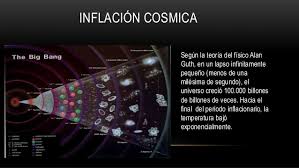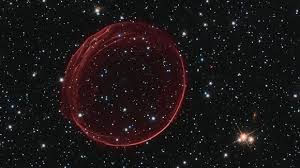THE CREATION AND DESTRUCTION OF OUR UNIVERSE
- planck
- Jul 18
- 8 min read
An engineer, an architect, and a physicist meet in a bar. The engineer says, "I'm capable of building the fastest engine in the world," to which the architect replies, "I'm capable of building the tallest skyscraper in the world." The physicist then exclaims, "I'm capable of explaining how the universe was created." (Everyone laughs... except the physicist.)
That science is able to explain how our Universe was created from (practically) nothing demonstrates the immense power of Physics and Mathematics. In this article, we will describe in detail the currently most widely accepted theory for explaining how our Universe emerged, first in a very schematic and intuitive way for people with little physics knowledge, and then in a more technical way. We will then explain how a mechanism similar to the one that created our Universe can lead to its destruction.
Welcome to the creation and (fortunately unlikely) destruction of the Universe!
The size scales of our Universe
Before we begin, we must realize how immensely small our Universe was and how immensely large it is today. Expressed in meters, where 100 = 1 m would be our natural human scale, the radius of our visible Universe (about 46 billion light-years) is approximately 1026 m, that is, a one followed by 26 zeros. This is why we say that on the large size scale there are 26 orders of magnitude above our natural scale. If this is already impressive in itself, it is even more impressive to know that on the small size scale there are 35 orders of magnitude below our scale!
This means that from our natural scale (1 m) to the smallest possible scale, the Planck scale (10-35 m), there are 9 orders of magnitude more than from our scale to the radius of the observable Universe. To get an idea of what this means, let's think that if we expand an atomic nucleus (10-15 m) until it has a radius equivalent to the distance from Earth to Alpha Centauri (4.3 light years), the Planck length would be 1 mm! The Planck distance would be the size of a louse living in the atomic nucleus expanded to the distance of the nearest star!

The problem is: How on earth did our universe, which emerged from a distance comparable to the Planck scale, grow to its current size? How did it expand by 61 orders of magnitude?
Cosmic inflation explained intuitively
All familiar materials or substances have positive mass and energy and generate positive pressure. Positive pressure means that these materials resist compression and tend to expand when pressure increases.
volume. A hypothetical substance under negative pressure would act in the opposite way: it would tend to be compressed and not expand; it would be such a compact substance that it would be practically insoluble.
Einstein's theory of relativity teaches us that to calculate the total energy density of a system, all possible types of energy must be taken into account: mass, electromagnetic radiation, pressure, heat, etc. Under normal everyday conditions, velocities and pressures are very low, so the energy density of bodies is mainly due to mass (remember that the famous formula E=mc2 implies that a small mass possesses an enormous amount of energy). However, in the earliest moments of the Universe (as we will see, even before the Big Bang), conditions were far from our normal everyday conditions. To calculate the total energy density under these conditions, we must resort to the so-called Energy-Momentum Tensor, which takes into account all sources of energy. The key is that while the mass and energy in this Tensor must always be positive, pressure (which contributes more to the total energy than mass) can be negative!
We can consider that for a very brief instant of time the energy density of an infinitesimal amount of substance contained in an infinitesimal volume remained constant. During this brief instant the pressure
that the substance exerts on the "walls" of the space that contains it is equal to the kinetic energy minus the potential energy V(Ø). The kinetic energy is: 1/2mv2, the speed is the derivative of the position with respect to time but as the density
of energy is constant this derivative is zero (the derivative of a constant quantity is always 0) and the pressure is: P=-V(Ø) We have a substance with negative pressure! This substance creates an enormous repulsive gravity and space suddenly expands brutally! This stage of exponential expansion is called cosmic inflation. By increasing the volume V, a substance with positive pressure would tend to expand such that the energy density would decrease and inflation would thus cease immediately. However, a substance with negative pressure, as V increases, tends to remain compressed and maintain its density, creating a small amount of mass from the available energy through the equation E=mc2. In this way, the increase in V produces an increase in M and the density remains constant so that the inflation process continues and space grows exponentially!
How inflation works explained in a more technical way
Let's start from some "standard" initial conditions: we have an energy Ep within an infinitesimal volume Vp, so we can speak of an energy density Dp, as we will see later. Although it may seem impossible, these conditions can even arise "out of nowhere" from a quantum fluctuation. We know that space-time is "full" of what are called quantum fields, the most elementary of all fields being the so-called scalar field. For this reason, it is logical to express the density
of energy Dp in the form of a scalar field Ø of potential V(Ø) that "permeates" all space.
A scalar quantum field can be represented in a graph in which the x-axis represents the value of the field and the y-axis represents its potential energy, for a fairly natural and simple potential field V(Ø )= 1/2m2Ø2 we would have:

The field can be visualized as an oscillator that possesses a certain energy depending on its oscillation state. The point at which the value of the field Ø is 0 is called the vacuum point of the field and represents a state of the field without vibrations, that is, without particles (in quantum field theory, particles are considered to be the vibrations of quantum fields, which are the fundamental physical entities). Normally, the vacuum state corresponds to the state of minimum potential energy, but sometimes this is not the case, and the field has a certain potential energy V in the vacuum state. This vacuum state is called a false vacuum and is a metastable state, since, at a certain moment, the field will fluctuate and fall toward the true vacuum state. The characteristics of this false vacuum state are surprising and will lead to the beginning of cosmic inflation.
While the field is in the false vacuum state (at the top of the hill), its energy density is constant; it doesn't change. Every quantum field is mathematically defined by the so-called energy-momentum tensor, which in our case is a tensor of the form:

The energy density D is given by the Too component of the energy-momentum tensor and its value is: D= Too= 1/2(dØ/dt)2+1/2(gradØ)2+V(Ø), the 3 remaining terms of the diagonal of the tensor represent the pressure exerted in the three spatial directions and their value is: P=1/3[sum(i=1, i=3)Tij]= 1/2(dØ/dt)2-1/6(gradiØ)2-V(Ø). This last expression tells us something very important: since the energy density and the value of the Ø field remain constant while the field remains at the false vacuum point, the derivatives of the field cancel out and the value of the pressure is P=-V(Ø) . That is, we have a negative pressure value!
If we consider a homogeneous and isotropic energy density in the equations of general relativity we obtain the so-called Friedmann-Robertson-Walker (FRW) equation: d2a(t)/dt2 = - 4pi/ 3 G(d + 3p)a, where d is the energy density, p is the pressure, G is Newton's gravitational constant and a is the scale factor. By including the conditions that generate negative pressure the solution to this equation is a(t) = ext where x=(8pi/3Gd)1/2 i.e.: the scale factor of the Universe grows exponentially!
The end of inflation: the Big Bang
To give an idea of the immensity of the numbers implied by inflation, if we consider the most accepted inflationary versions , the scale factor a of the Universe grows by about 26 orders of magnitude in just 10-35 seconds!
Inflation ends when the scalar field Ø, also called inflaton field, descends to the true vacuum point. At this point, the potential is 0, but the value of the field is non-zero, i.e., the vibration of the field is not zero, which translates into the appearance of vibrations, i.e., particles. The potential energy stored in the field Ø is converted into kinetic energy and particles. This is the beginning of the Big Bang!
A Universe emerged from nothing
The Heisenberg uncertainty principle tells us that the uncertainty in energy times the uncertainty in time cannot be greater than Planck's constant, so we can "steal" a certain amount of energy E by returning it very quickly.
In fact, mathematical calculations indicate that a small Universe can emerge from a quantum fluctuation if the energy density is of the order of the Planck density, precisely the "standard" initial conditions necessary for the beginning of cosmic inflation. The law of conservation of energy would not be violated since the positive energy of the mass-energy produced would be compensated by the negative energy associated with gravity. In this way, and although it may seem incredible, the entire Universe could have a net energy equal to zero! Could the Universe have emerged from a quantum fluctuation?
The destruction of our Universe
Cosmic inflation requires a scalar field (called the inflaton field) in a false vacuum state to function. Now we might ask: If our Universe began in a false vacuum state, how do we know that the current state of our Universe is the ultimate true vacuum state? Couldn't it be another false vacuum state?

The vacuum of our Universe could have several false vacuums in which a transition to the true vacuum or to another false vacuum of lower potential could occur through quantum tunneling.
On July 4, 2012, the discovery of the Higgs boson was announced. The Higgs field determines the vacuum energy of our Universe, so its study is essential to determine whether we are in a stable true vacuum or an unstable false vacuum. We still don't have a definitive answer, as there are significant uncertainties in the values of the parameters to be considered. A rough estimate shows the following:

The conclusion is that, although we don't yet have a definitive answer, it's possible that our Universe isn't in a stable region of true vacuum! It's possible that we're in a metastable region. What would happen if, at some point, our Universe "jumped" to a lower energy level? The answer sounds like something out of a science fiction movie: a bubble of true vacuum would form, expanding at the speed of light, destroying everything in its path!
Fortunately, we don't have to worry too much about this. We know this hasn't happened for at least 13.8 billion years, and the probability of it happening in the next billion years is practically negligible. If the value of the Higgs field had placed the vacuum of our Universe close to the instability zone, we wouldn't be here reading this. This is another of the many fundamental quantities that possess the necessary value to allow conscious beings in the Universe to study and marvel at the enormous beauty of nature.









Comments